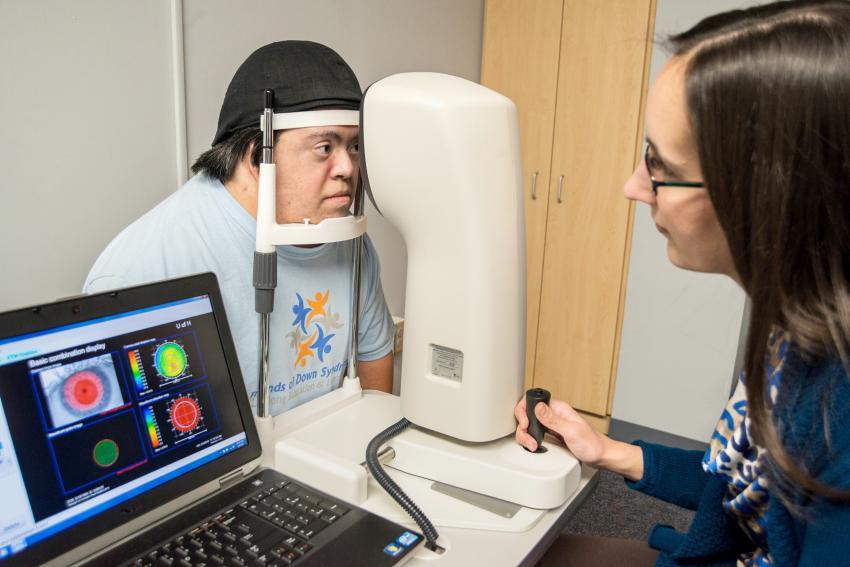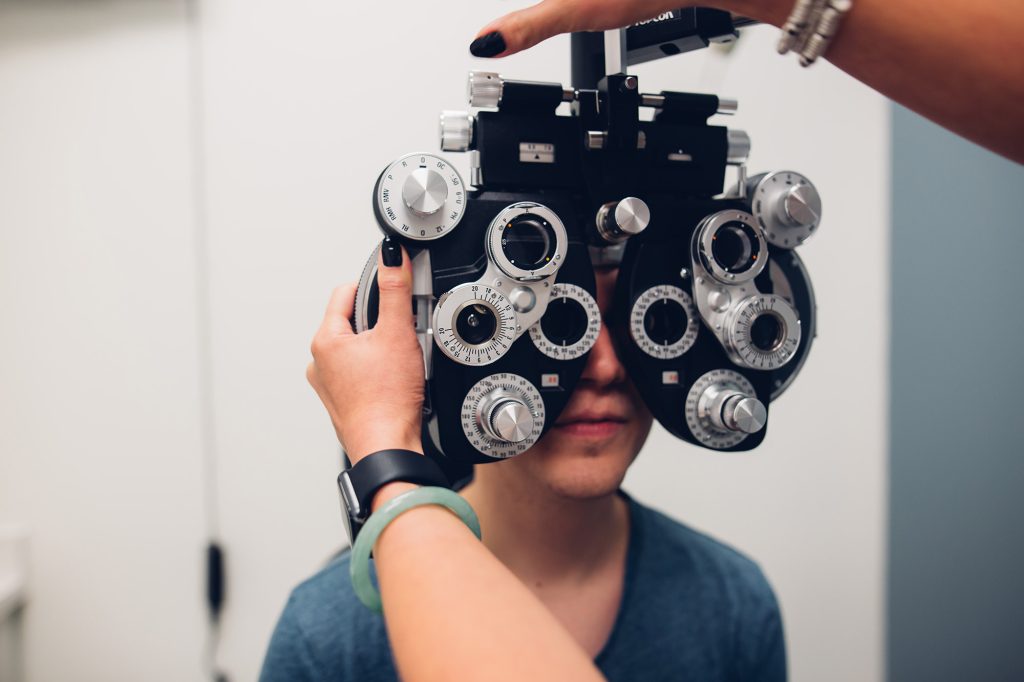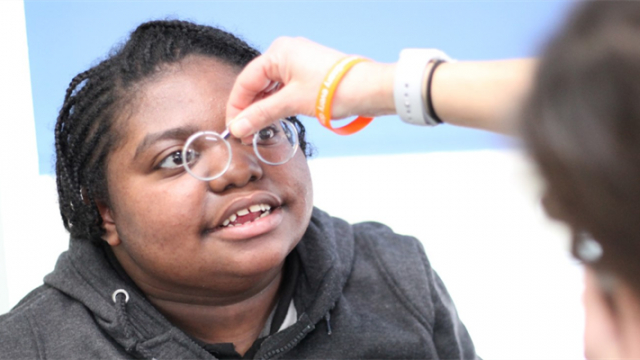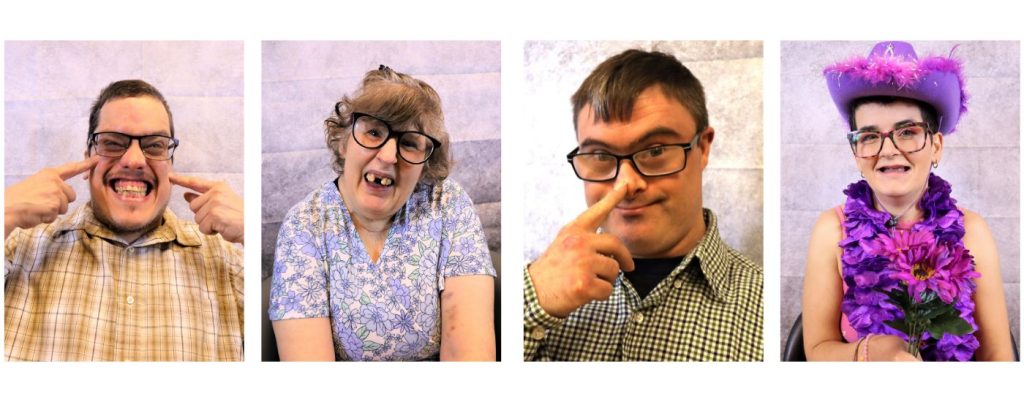
“Many people think eye exams are only necessary when there’s a change in their vision. However, annual eye exams are a vital part of maintaining your eye health and overall well-being. At All About Eyes, we emphasize the importance of yearly eye exams to ensure your vision is clear and healthy.” [1]
How important are eye exams for adults with developmental disabilities?
“As we age, our eyesight changes. Most of these changes are normal, age-related changes that do not present a serious threat to one’s well-being. However, as we live longer, more and more people will experience a significant impairment of their vision that will hinder their ability to function independently on a daily basis. It is very important that older adults see an eye care specialist on a regular basis since many causes of vision impairment are treatable and vision loss can often be prevented.
Also, a change in a person’s behavior resulting from an undiagnosed vision problem could be mistaken for another serious problem, e.g., Alzheimer’s Disease. Accurate diagnosis and treatment are critical for the person’s well-being as he ages.” [2]
If an adult with a developmental disability does not read or do any close work using her eyes, is an eye exam still necessary? “Yes, an eye exam will detect if the individual has an eye disease. Many treatable causes of vision loss are never apparent to someone looking from the outside, without the aid of special instruments. If left untreated, eye diseases can cause blindness or severe impairment which can interfere with an individual’s safety in walking, the ability to understand what is expected of her, or the enjoyment of her surroundings.” [2]

People with an intellectual disability who are most at risk of sight problem
“The fact that someone has a learning disability automatically increases his/her chance of experiencing a sight problem. However, there are specific groups of people within the intellectually disabled population who are particularly at risk of developing certain sight problems:
People with Down’s syndrome often experience: Refractive errors (the overall term used for conditions which affect focusing):
- Hypermetropia – long-sightedness
- Myopia – short-sightedness
- Astigmatism – when the curve of the cornea is not symmetrical
- Nystagmus – an involuntary movement of the eyes
- Strabismus – squints
- Cataracts – a clouding of the lens
- Eye infections
- Keratoconus – a condition where the cornea stretches causing the tissue to thin and the center to bulge.” [3]
“People with cerebral palsy often experience:
- Optic atrophy – damage to the optic nerve which is responsible for transporting visual information to the brain
- Cortical blindness – sight problems (not necessarily a total loss) that are as a result of damage to the part of the brain that processes visual information
- Nystagmus – an involuntary movement of the eyes
People with Rubella syndrome often experience:
- Congenital cataracts – clouding of the lens
- Microphthalmos – small underdeveloped eyes
- Inflammation of the iris (the colored part of the eye)
People with Fragile X syndrome often experience:
- Hypermetropia – long-sightedness
- Strabismus – squints” [3]
“People who communicate using behaviors that put their eyes at risk of damage: For example:
- People who bang their head or face slap
- People who eye poke or eye rub” [3]
“Older people often experience:
- Presbyopia – age related long-sightedness
- Difficulties with light/dark adaptation
- Age related macular degeneration – damage to the macular which is the part of the retina responsible for central vision; the vision needed for detailed activities and color perception.
- Cataracts – clouding of the lens
- Glaucoma – caused by raised pressure in the eye.”
“People from different ethnic origins may experience:
- Glaucoma – more prevalent amongst Afro-Caribbean and Asian people
- Sickle cell disease – this disease can cause problems in the retina and is more prevalent amongst Afro-Caribbean and Asian people
- Lupus – this disease can cause light sensitivity and is more prevalent amongst Afro-Caribbean and Asian women
- CMV retinitis – this is an eye infection affecting people with AIDS and is more prevalent amongst African people.” [3]
People with diabetes often experience:
- “Cataracts – clouding of the lens
- Temporary blurring – when a person develops diabetes, they may have a period of blurred vision until the diabetes is under control
- Diabetic retinopathy – this is a condition that affects the blood vessels in the retina and can affect vision in a number of ways.” [3]

“Potential strategies for engaging the patient include:
- Interact in the waiting room first before transitioning to the exam room.
- Sing nursery rhymes.
- Playing a video of a favorite character on an acuity screen or phone.
- Give them something interesting to hold.
- Give plenty of positive reinforcement after checking for preferred methods (ex., high fives).
- Don’t be afraid to do appropriate testing in a non-exam chair if more comfortable for the patient.
- Redirect the patient to an interesting task or stimulus if they are distracted.
- Talk about their favorite singer, celebrity, book, movie, etc.” [5]
Recognizing the unique healthcare needs of patients with IDDs
“It is vital to remember that each person with a disability is a unique human being, and it is impossible to generalize or universalize each person’s needs or characteristics. They are not defined by their disabilities, and they deserve a comprehensive eye exam to meet their visual needs.
Terminology about disabilities continues to be an evolving topic. Some patients and their families may identify with the term “disability,” while others may see themselves as “differently abled.” The provider should follow their lead in referring to their abilities.” [4]

“Continuous monitoring is vital to managing eye conditions effectively. It allows us to track changes in vision, adjust prescriptions as needed, and recommend necessary lifestyle adjustments. Routine check-ups help ensure that any assistive technology in use is well-suited to the current level of visual impairment, maintaining optimal vision and enhancing overall health.” [6]
Resources
[1] https://www.allabouteyes.com/2024/10/30/why-you-should-prioritize-regular-eye-exams/
[2] https://disabilitynavigator.org/article/12513/aging-developmental-disabilities-changes-vision
[4] https://eyesoneyecare.com/resources/best-eye-exam-practices-for-patients-with-idds/
[6] https://nelowvision.com/why-regular-eye-exams-matter-for-those-with-visual-impairments
